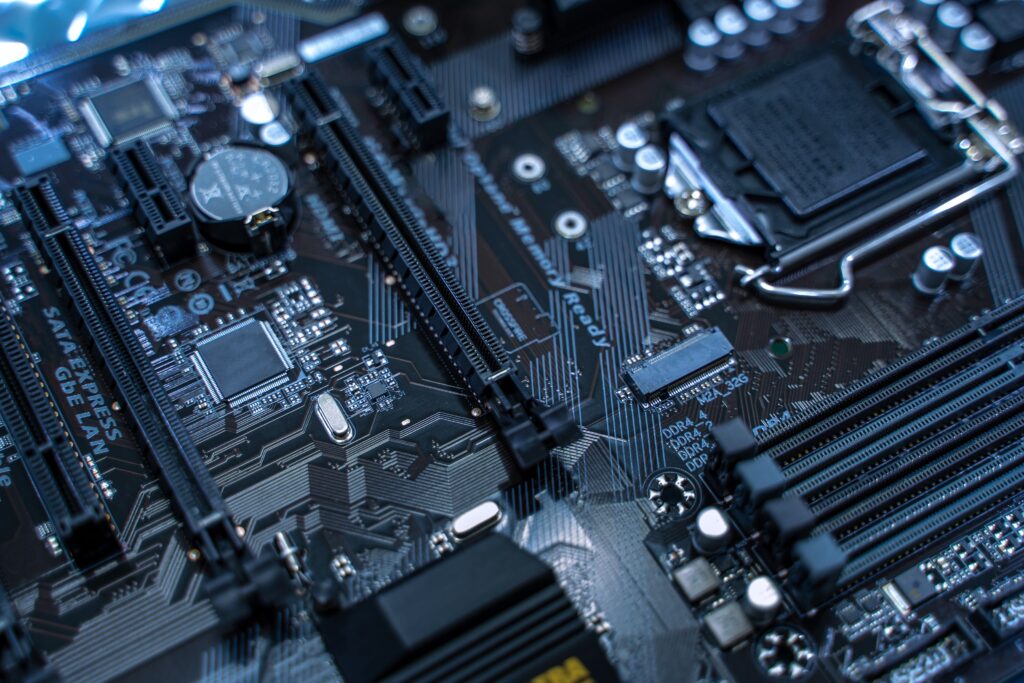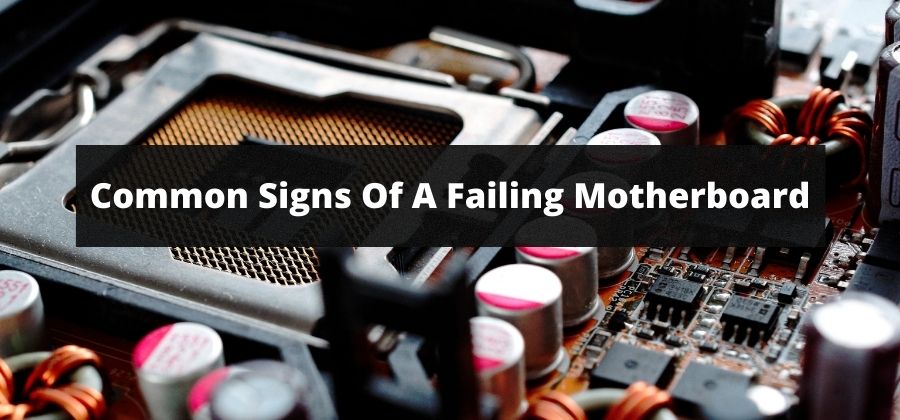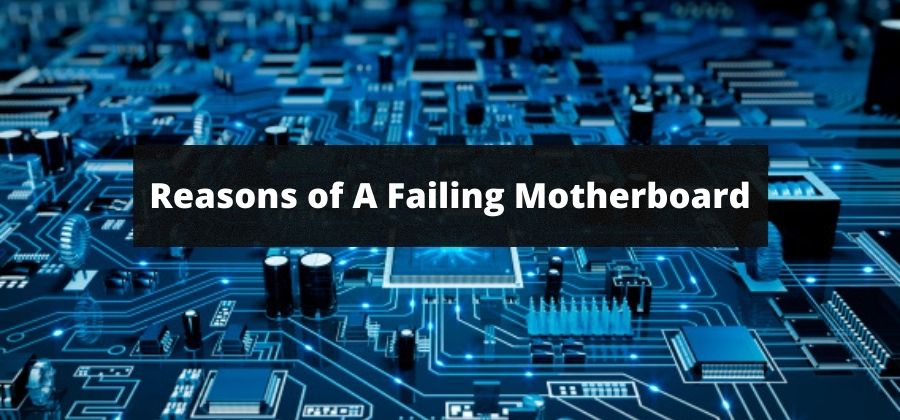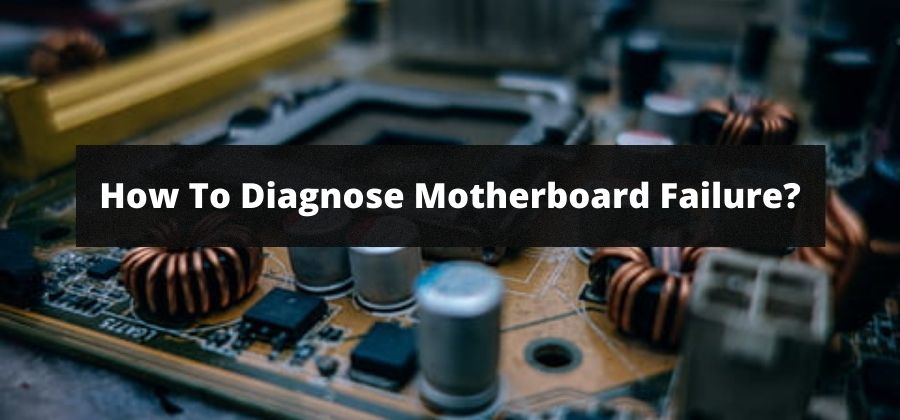Has your system started acting up? And guess what there are some hefty chances that your motherboard is starting to fail. Glitches, black screen and random lags thanks to the failure in the motherboard.

Seems terrifying right? Oh yeah it does and of course it actually is! We have covered each and every sign of failing a motherboard ranging from probable causes along some tips to prevent the failure in this article. Long story short at first we need to know what are the most common signs of an unfortunate motherboard failure.
Read through the next section to know all about the reasons of a failing motherboard and whether the problem exists in the motherboard or some other hardware.
What Are The Common Signs Of A Failing Motherboard?

Now there can be many signs your system is at the stage of failure but not every sign would mean your motherboard is the culprit. To make it easier for you to decide whether your motherboard is the one making fuss we have compiled some of the most common signs of its failure below.
Power button Doesn’t Turns On The system
One of the most common way you can detect that your motherboard is shutting down is when the power button doesn’t turns on your system.
so you have been pressing the power button again and again yet it doesn’t make any change.
Or your system turns off automatically in between a task. The later one doesn’t necessarily mean that your motherboard is getting failed.
Often there can be some problems in the PSU that might not let you turn on the system. To know the proper cause it is important to unplug the system and have a check on the motherboard.
Plugging In PSU And Getting No Response
Now, another sign of a motherboard failure might include the system not getting started even the PSU is in good condition. Most often a PSU when plugged into a faulty motherboard might not make any difference to the system.
to know whether the motherboard is the one at fault plug in the same PSU into another running system. If it is working then there are some good chances your motherboard failed. But if not then the PSU was at fault.
Beep Codes
You are hearing weird annoying beeps from your system and don’t know what is making all these? If yes, then let us tell you this is how it sounds when your motherboard starts to fail.
Beeps and blackouts all are some of the most common signs of a motherboard that is going to die soon. Besides at this point you can also checkout for the power light of your motherboard.
And if that light is turned off then this is one of the biggest indicator that your motherboard is at the verge of getting out of work.
Visual Inspection
Besides above technical signs there can be some other signs that might help to give you an idea of a motherboard failure. The one that remains at the top is visual inspection of the hardware. Most of the time we ignore the impact our hardware go through.
Lookout for the bulges or bent over the motherboard or anywhere near it. Also make sure the capacitors are in working position. If by any chance they are not then these are some of the most obvious signs of a motherboard failure.
Why Do Motherboard Fail?

Till now we have discussed some of the probable signs of a motherboard when it is failing. But why does a motherboard fail? Like we do know you aren’t abusing it or smashing it against the table.
Then why does a motherboard fail? There are some probable causes behind a motherboard failure. But do remember motherboard is a hardware and it will go through a shutdown phase not today but tomorrow.
Electrical Surges
Lightning can cause electrical surges in a facility’s electrical wiring and distribution panel. The surges can damage the electrical system’s wiring and other components, potentially causing a fire.
If a panel is damaged, it must be replaced with a new, surge-protected panel. If the SFP is not installed in the electrical panel, a surge protector must be used to protect the panel.
Heating Up Issues
The components on the motherboard can be damaged by overheating. If the motherboard is heated up, it may cause issues like the processor may not function properly.
Or the memory modules or the chipset may not function properly. If you notice that the processor is not working properly, you need to get the motherboard checked out immediately.
This will prevent more damage and help you avoid a total motherboard failure. It’s important to keep the components of the motherboard cool. This will help them function properly. A wise decision here would be purchasing a CPU cooler along your system.
Bending Or Impact
The bending or impact over the case of the motherboard can cause damage to the motherboard. If you are not careful when you assemble your computer, the motherboard may be damaged. One of the most common ways of the motherboard getting damaged is by bending.
Another common way of damaging it is by dropping a heavy object on it. If the motherboard is damaged, it will cause the computer to not work properly. Try to handle your system very carefully and avoid placing it at high levels or a risky place.
Dust Accumulation Inside The Motherboard
It is an important aspect of a motherboard’s design to keep the dust out of the board. Often there are some good chances that your motherboard has stopped working because it has accumulated a lot of dust.
When such things get stuck into your system’s hardware it will render the performance of your system. Just like when the arteries are blocked the blood flow is disrupted in the same way when dirt is accumulated on the motherboard it clogs up the normal working order.
Wear And Tear
Wear and tear is a usual cause of a motherboard failure. See every hardware has a defined life span. And to get past over that life span and have your system working just like the new one is just very very rare!
Now the secret here is that a motherboard can actually last you a good 20 years. Yes, that is true! But wait that is not all! A motherboard has some components that can wear out with time. Eventually failing your motherboard. And this is not something you can prevent because it is a natural process.
Design Defects (Rare)
Design defects aren’t something you might come across more than often. There might be some rare context that you receive a motherboard that is built faulty and therefore fails out because of the defects.
As not everything that is brand new works just fine so we have included this cause here. Often there can be factory defects that might alter the operation of your motherboard. For this purpose you can contact the manufacture to get a replacement.
How To Diagnose Motherboard Failure?

There are many ways to diagnose a motherboard failure, and they can be divided into two categories: hardware failure and software failure. Hardware failure means that you have to replace the faulty component or components, while software failure means that you have to fix the problem.
The BIOS (Basic Input Output System) is the first piece of software that your computer boots into when it is powered on. The BIOS provides basic information about your computer system and is responsible for setting up the system hardware such as the CPU, memory, hard drives and network cards.
The most common method to diagnose a motherboard failure is by looking at the BIOS settings. The BIOS settings provide important information about your computer, and one of the most important settings is called ‘BIOS POST’.
This is the screen where you will see all of the information about your computer including the boot order, any errors that were found during booting, and a description of the current status of the system. The other most common way to diagnose a motherboard failure is by using the system monitoring software.
System monitoring software allows you to monitor the status of your computer and even take control of it. For example, if your computer has a memory failure, then it will display an error message on the screen. If your motherboard has a power failure, then you will lose all of the data on your computer hard drive.
On the other hand, if your computer is having a hardware failure, then it will not boot up at all. So the first thing you need to do is to check whether your computer boots up or not. If it doesn’t boot up, then you need to determine whether it boots into BIOS or the operating system (OS). If it boots into BIOS, then you have a motherboard failure.
How To Prevent Motherboard Failure?

Enough signs and causes now comes the actual part how to prevent motherboard failure. Till now you might be aware of some of the ways to avoid motherboard failure.
For making it straightforward to remember on your tips we have divided them into looking out for short circuits and power surges, regular clean-up of the vents, avoid improper handling, and purchase compatible components. Let’s have a look at each of the ways you can make your motherboard last long one by one.
Lookout For Short Circuits
The motherboard is an electronic circuit board on which most of the components of a computer are mounted. It is also called printed circuit board or PCB (Printed Circuit Board). If you look at your motherboard, you will find it made up of several layers of copper-clad laminate.
The copper-clad laminate is used to carry signals and power between different parts of the motherboard. Make sure all the components are organized and neat and won’t catch any fire.
Regular Cleaning Of The Ventilation Outlets
This is a very important task, even if your motherboard is in a closed case. Dust, dirt and other particles can block the outlets and make the cooling less efficient.
To avoid this to happen at any cost try to use a vacuum cleaner to clean the dust and dirt from the ventilation outlets. This will also make sure the flow of air remain static and your system is cold as ice.
Take Care Of The Power Surges
When you buy a new motherboard you will want to have a power supply that will keep your system running smoothly. If the power surges are not taken care of, you can end up with a fried motherboard. It is important that you have an adequate amount of power in your system.
This means that you should not be using a power supply that is rated for less than your needs. Always check the power supply’s amperage and voltage. If they are low, replace it immediately. Do not hesitate to replace it if you suspect that it is not sufficient.
If your power supply has a large capacity, do not leave the computer for long periods of time on a stand with no power supply. You can cause damage to the motherboard and the whole system.
Avoid Improper Handling
Be careful when handling the motherboard, avoid bending or twisting it. When using a motherboard in a system, please put the motherboard on a flat and stable surface. Do not place the motherboard near any heat source, such as a radiator or the like.
Also, do not use a power cord that is damaged or frayed. Make sure that the power cord is fully inserted into the power connector on the motherboard. Failure to do so may damage the motherboard. Avoid touching or moving the adapter when it is being powered on.
Go For Compatible Components of the motherboard
Most importantly if you are going to build a system for yourself try to purchase components that are compatible with your motherboard. Now just imagine if you plug your microwave in a power unit that is higher than its voltage capacity.
What will happen is that it will probably get short circuit or in the worst scenario it might burn off. For this always make sure all of your components are easy to get along with your selected motherboard.
What Shall I Do With A Failed Motherboard?

The first thing to do is to make sure that it is actually a failed motherboard and not just an issue with one of the other components.
If you have made sure that the problem is because of the motherboard failure then there are two probable things that you might do. Firstly if it is repairable you can repair it. However, If it is damaged beyond repair then you might consider it replacing.
Conclusion
Hopefully we have answered each and every of your queries regarding why do motherboards fail. Make sure that you note the points mentioned in this article to prevent your motherboard from failing.
Additionally, try to purchase those hardware that is gets well along your motherboard and arrange them neatly inside the PC case as to avoid damage. Best of luck!